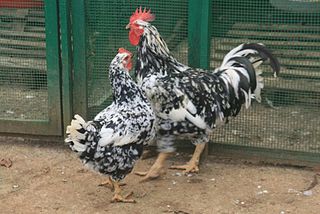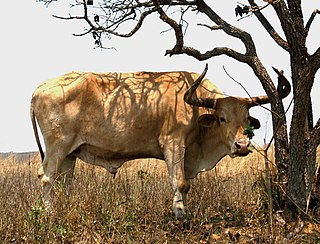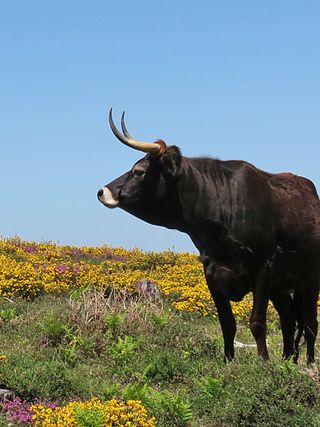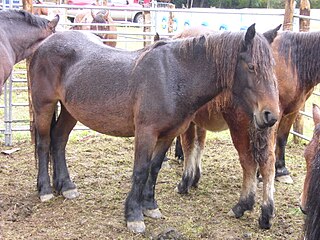Related Research Articles

The Charolais or Charolaise is a French breed of taurine beef cattle. It originates in, and is named for, the Charolais area surrounding Charolles, in the Saône-et-Loire department, in the Bourgogne-Franche-Comté region of eastern France. Charolais are raised for meat; they may be crossed with other breeds, including Angus and Hereford cattle.

The Mangalarga Marchador is a Brazilian breed of riding horse. It is the national horse breed of Brazil, where there are more than half a million of them; it is among the most numerous breeds of riding horse in the world. It derives from cross-breeding of Portuguese Alter Real horses with local Criollo stock. It displays four gaits: the walk, the canter, and two ambling gaits, the marcha batida and the marcha picada; it does not trot.

The Criollo, or Crioulo, is the native horse of the Pampas with a reputation for long-distance endurance linked to a low basal metabolism. The breed, known for its hardiness and stamina, is popular in its home countries.

Nelore or Nellore cattle originated from Ongole Cattle cattle originally brought to Brazil from India. They are named after the district of Nellore in Andhra Pradesh state in India. The Nelore has a distinct large hump over the top of the shoulder and neck. They have long legs which help them to walk in water and when grazing. The Nelore can adapt to all except very cold climates. They are very resistant to high temperatures and have natural resistance to various parasites and diseases. Brazil is the largest breeder of Nelore. Nelore have the shortest ears of most Bos indicus types. There is a naturally polled strain of the breed.

The Pita Pinta Asturiana is a Spanish breed of chicken. It is the only chicken breed indigenous to the principality of Asturias, in north-western Spain.

The Gir or Gyr is one of the principal Zebu breeds originating in India. It has been used locally in the improvement of other breeds including the Red Sindhi and the Sahiwal. It was also one of the breeds used in the development of the Brahman breed in North America. In Brazil and other South American countries the Gir is used frequently because, as a Bos indicus breed, it is resistant to hot temperatures and tropical diseases. It is well known for its milk producing qualities and is often bred with Friesian cows to make the Girolando breed.

The Campolina horse breed of Brazil is named after Cassiano Campolina, the farmer who developed the breed. Beginning in 1870, they were developed using several different breeds of horses. The Campolina is one of the larger Brazilian breeds, and may be found in most colors. They are a gaited breed, with an ambling gait. They are used mainly for leisure riding and driving and are increasingly used for dressage within Brazil.
The Pantaneiro is a cattle breed from the Pantanal region of Brazil, where it has been raised for more than three hundred years. It is now considered to be at risk of extinction.
Crioulo Lageano longhorn beef cattle originated from cattle originally brought to Brazil from Portugal by the Jesuits 400 years ago. The breed was probably domesticated 4000 BC in Egypt, it came to the south of Spain from the North of Africa. The center of the rest population is the plateau of Lages, Santa Catarina, Brazil.

The Caracu is a Brazilian breed of beef cattle. It is a Criollo breed, derived from European cattle brought to Brazil by the conquistadors; it has little or no zebuine influence. It was originally a triple-purpose breed, used for draught work and transport, for meat and for milk; in the twenty-first century it is reared principally for beef, but there are also dairy lines. It has contributed to the development of a number of other breeds, among them the Caldeano. It is closely similar to the Mocho Nacional, a polled breed, and it is probable that the two will be merged.
The Retuertas or Caballo de las Retuertas is a Spanish breed of horse indigenous to Andalusia. It is found only in the Doñana National Park in the provinces of Huelva and Sevilla, with a conservation herd in the Campanarios de Azaba Biological Reserve in Espeja a part of which is the research reserve of the Consejo Superior de Investigaciones Científicas, the Spanish National Research Council.

The Maronesa is a traditional Portuguese breed of mountain cattle. Its name derives from that of the Serra do Marão, which lies in the Trás-os-Montes and Douro Litoral regions in the northern part of the country. Its primary use is for draught power.

The Minhota or Galega is a Portuguese breed of cattle. It is reared principally for beef; in the past it was used also as a draught beast and for milk.

The Asturcón is an ancient breed of small horse or pony from the autonomous region of Asturias in northern Spain. It has been documented since Roman times: it has an unusual ambling gait, which was described by Pliny the Elder in his Naturalis Historia. It is of Celtic type, and shows similarity to the Pottok and Losino of Spain, the Garrano of Portugal, and the Dartmoor, Exmoor, Fell, Highland, Shetland and Welsh breeds of the British Isles.

The Jaca Navarra, or Navarrese Horse, is a Spanish breed of small horse from the autonomous community of Navarre in the north-eastern part of the country. In 2013 it was listed in the Catálogo Oficial de Razas de Ganado de España in the group of autochthonous breeds in danger of extinction. The total population of the Jaca Navarra has been variously estimated at 350, 250, and 240 and decreasing. In April 2011 the total population was reported to be 899, all of which were in Navarre. In 2000, and again in 2007, it was listed by the FAO as endangered.

The Burro da Ilha Graciosa or Burro Anão da Graciosa is a breed of small domestic donkey endemic to the island of Graciosa, in the North Atlantic archipelago of the Azores, which are an autonomous region of Portugal. It is critically endangered, but is not officially recognised or reported to the DAD-IS database of the FAO. Efforts are being made to obtain official recognition and protection of the breed.
The Campeiro is a breed of small horse from Brazil. It is thought to descend from horses brought to South America in the sixteenth century. Because it has an ambling gait and comes from the area of the Araucária forests of southern Brazil, it may also be known as the Marchador das Araucárias.

The Pampa Horse is a Brazilian breed of riding, sport and working horse. It combines the conformational characteristics of Brazilian Horses that are gaited with a pinto spotting pattern of white and dark coat colors. Developed from a base of spotted horses of the Mangalarga Marchador, Campolina, Brazilian crossbred horses, and others. It is a color breed: only pinto horses may be registered.

The Nordestino, also known as Crioulo Nordestino, Mourão, Pé Duro Nordestino or Sertanejo do Nordeste, is a breed of horses native to the Northeast Region of Brazil. The breed is near extinction due to the lack of interest in maintaining it. A stud-book was created and approved in 1987 by the Brazilian government; nevertheless in 2017 the authorization to carry out the genealogical records of the breed was revoked by the Ministry of Agriculture causing the loss of the breed's lines records. It is the first native horse breed of Brazil, and derived from the first horses brought by Portuguese settlers in the sixteenth century. Over time the horses have evolved into a small breed very well-adapted to surviving in the local semi-arid climate of the Northeast Region. Today around 500,000 horses survive in the region pulling horse carts or in cattle work.

The Lavradeiro or Roraima Wild Horse is a feral horse that inhabits the savannah region of Lavrado in the northeast of the state of Roraima, in Northern Brazil. It is considered one of the main symbols of the state and is one of the last populations of wild horses in the world, currently at risk of extinction.
References
- Breeds reported by Brazil: Horse. Domestic Animal Diversity Information System of the Food and Agriculture Organization of the United Nations. Accessed September 2015.
- História (in Portuguese). Associação Brasileira dos Criadores do Cavalo Pônei. Accessed September 2015.
- Andrade, Lúcio Sérgio (20 September 2013). "Origem do Pampa". Associação Brasileira dos Criadores de Cavalo Pampa. Archived from the original on 20 September 2013. Retrieved 12 August 2022.
{{cite web}}: CS1 maint: date and year (link) - Estatuto Social (in Portuguese). Associação Brasileira de Criadores do Cavalo Andaluz-Brasileiro. Accessed September 2015.
- Arthur da Silva Mariante, Concepta McManus, José Francisco Mendonça (editors) (2003). Country Report on the State of Animal Genetic Resources: Brazil. Brasília: Embrapa Genetic Resources and Biotechnology. ISSN 0102-0110, 99. Annex to: Barbara Rischkowsky, Dafydd Pilling (editors) (2007). The State of the World's Animal Genetic Resources for Food and Agriculture. Rome: Commission on Genetic Resources for Food and Agriculture, Food and Agriculture Organization of the United Nations. ISBN 9789251057629. Archived 10 January 2017.